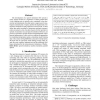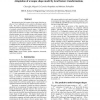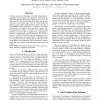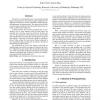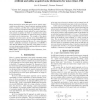INTERSPEECH
2010
13 years 7 months ago
2010
In this paper we present a method to predict the movement of a speaker's mouth from text input using hidden Markov models (HMM). We have used a corpus of human articulatory m...
INTERSPEECH
2010
13 years 7 months ago
2010
Automatic language identification (LID) systems generally exploit acoustic knowledge, possibly enriched by explicit language specific phonotactic or lexical constraints. This pape...
INTERSPEECH
2010
13 years 7 months ago
2010
The paper investigates a new method to solve concatenation problems of Mandarin speech synthesis which is based on the hybrid approach of HMM-based speech synthesis and unit selec...
INTERSPEECH
2010
13 years 7 months ago
2010
The amount of available Thai broadcast news transcribed text for training a language model is still very limited, comparing to other major languages. Since the construction of a b...
INTERSPEECH
2010
13 years 7 months ago
2010
The development of a speech translation (ST) system is costly, largely because it is expensive to collect parallel data. A new language pair is typically only considered in the af...
INTERSPEECH
2010
13 years 7 months ago
2010
Reconstructing the full contour of the tongue from the position of 3 to 4 landmarks on it is useful in articulatory speech work. This can be done with submillimetric accuracy usin...
INTERSPEECH
2010
13 years 7 months ago
2010
French is known to be a language with major pronunciation irregularities at word endings with consonants. Particularly, the well-known phonetic phenomenon called Liaison is one of...
INTERSPEECH
2010
13 years 7 months ago
2010
Our goal is to automatically learn a perceptually-optimal target cost function for a unit selection speech synthesiser. The approach we take here is to train a classifier on human...
INTERSPEECH
2010
13 years 7 months ago
2010
In this article, we propose an innovative way of estimating pitch from speech waveform data, using an iterative ARMA technique that efficiently estimates multiple frequency compon...
INTERSPEECH
2010
13 years 7 months ago
2010
Recent research has shown that speech can be sparsely represented using a dictionary of speech segments spanning multiple frames, exemplars, and that such a sparse representation ...

